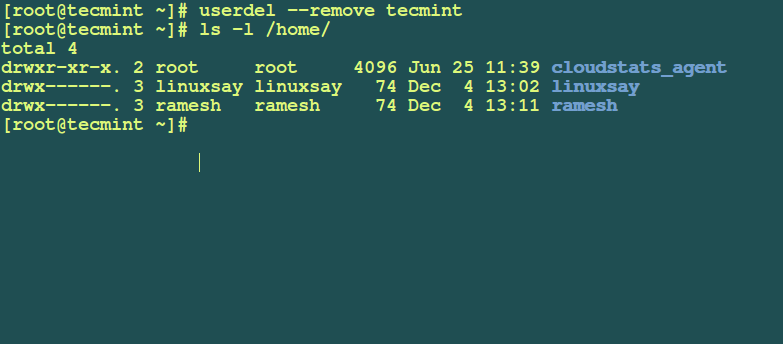Table of Content
In order to set these values and have them take affect the user’s account must support password lifetimes. The example below will create a new user named student and set their home directory to /home/students/student1. The second to the last field is the user's home directory.

Create directory in compliance to /etc/passwd, usually there will be already a /home/login entry. Check /var/log/secure for why the directory is not able to be created. Unable to create and initialize directory ‘/home/tdunphy’. You may also need to restart sssd or nslcd, depending upon which one is running the backed ldap connection service on the clients.
Not the answer you're looking for? Browse other questions tagged linuxuser-management or ask your own question.
Please note that you must run the above command as root user or different sudo user. There are several ways to accomplish this task, but simplest is to add the user to the wheel group. For example, to set a user’s password to expire in 90 days, with a minimum of 2 days, you would run the following command.

I would like to create a home directory for the user and also give them root provileges. You can use something like pam_mkhomedir to prevent this from ever being an issue with any users in the future. You know now how to create home directories after creating the users. This can be useful when you forgot to include -m option while creating users with useradd command.
Creating a System User
Other users include bin, daemon, systemd-network, among many others. These are for when these entities need to access the system. VPS Hosting Lightning-fast cloud VPS hosting with root access.
This website is using a security service to protect itself from online attacks. The action you just performed triggered the security solution. There are several actions that could trigger this block including submitting a certain word or phrase, a SQL command or malformed data.
Your Answer
This enforces the idea that the user is cannot have a login session, such as through SSH. A best practice to prevent someone from breaking into the system with a system user. Instead, to set a password for the new user use the passwd command.

To create a new user with a specific shell you use the -s or --shell flag. No value is added by repeating what another answer already explained two years ago. Running the command on other machines would have no effect. User Details - usually you’ll find the user’s first name. Password - indicated by the letter x, you can also find this encrypted password in the /etc/shadow file.
Create a New User With a Different Home Directory
Set the UID to the next available ID, incrementing from 1000 for regular users. Needs to review the security of your connection before proceeding.

The most basic example of creating a new user in CentOS is to use the useradd command. In this tutorial, you will learn how to create a user on CentOS using the useradd command. You also see several common and real world examples of user creation. Adduser is an interactive wrapper to useradd - it is not appropriate in scripted solutions, particularly dockerfiles. The home directories weren't created because he forgot a switch.
Some users are only expected to exist for a specified period of time. Afterwhich, the user should be effectively disabled on the system. For example, to create a new user named sysadmin1 and add them to multiple groups, you would do the following. This strategy involves the creation of multiple groups, each with its own privileges. In order to add a new user to multiple groups, you use the -G or --groups flag. As system user does not expire by default and it given a unique identifier from a range reserved for such accounts.
Database Hosting Redundant servers and data replication to keep critical databases online. By default, on CentOS, members of the wheel group have sudo privileges. Linuxize.com needs to review the security of your connection before proceeding. In the following example, the new user student1 is added to the wheel group, giving him sudo rights. Deleting users is often need to remove unnecessary users that naturally build up over time.
File, the user may or may not have been assigned a home directory. If the CREATE_HOME is configured to yes, a home directory will be created for the new user by default. This time you will not get any warning message, because the home directory for the user called ostechnix has been created with mkhomedir_helper command. For example, to add an expiration date to a newly created user you would run the following useradd command. In this article we will share the procedure to create new user without home directory in Centos.

So let us create the home directory for the existing user (i.e. ostechnix in our case) with mkhomedir_helper command. You forgot to copy the contents of /etc/skel/ + chown recursive for those new files. Usermod wouldn't work since here the directory was registered but not created, usermod won't do anything. Default Shell - A shell allows for an environment where users interact with the server and the type of shell assigned allows for different usage. The /bin/bash shell allows for text files to run commands. However, we can actually place a user’s home directory just about anywhere you’d like.
Creating a User and Adding Multiple Groups
In this example above, you’ll see each field is separated by colons. Lets breakdown the sections to provide more information on the user. Fully Managed Hosting More than just servers, we keep your hosting secure and updated. Storage & Backups Data protection with storage and backup options, including SAN & off-site backups. High Performance Multi-server hosting solutions to reduce latency and prevent downtime.
















